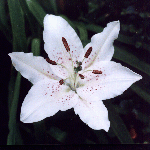 |
LILIACEAE - The Lily Family
This is one of the largest plant families, with about 3500 species distributed throughout the world. They are mainly ornamental plants, but include vegetables of the onion family (Onion, Garlic, Leek, Chives) and Asparagus, and some species have been used medicinally. The majority are herbaceous with a swollen storage organ, but there are also evergreen succulents (Aloe) and woody evergreen climbers (Lapageria). |
Characteristics of this Plant Family:
Leaves, Stem & Roots ~ The leaves of this family are often long and thin with parallel veins arising from the base (Ornithogalum, Eremurus), or oval with net veins arising along the stem, as in Trillium. In extreme cases, they have been reduced to scales (Asparagus) or modified to extend into tendrils (Gloriosa). or even needles (Borya). Many members of the family are perennial and have storage organs such as bulbs, corms or rhizomes.
The Liliaceae are monocotyledons, that is, they have only one seed leaf.
Flowers ~ The flowers are often borne in racemes, although they may also be solitary as in the Tulip. They usually have six petals which may be joined to some degree, may form a tube (Kniphofia), may be of different sizes (Calochortus) or may all be of equal size and shape. There are nearly always six stamens.
Seeds ~ The ovary (seed pod) in this Family is usually superior (inside the flower) with three chambers, with the seeds arranged in two rows in each chamber. Seeds of many species are round, flat and papery, although they may also be black and round.
(Click here for more information and examples of seedpods in this Family.)
Members of this Family usually have:
Bulbs or other storage organs
Long, thin leaves
Six petals
Six stamens
Seed capsule which forms inside the flower
Note: Several groups of plants in the Family Liliaceae have now been given their own Family status. These include Alliaceae, Alstroemeriaceae, Amaryllidaceae, Asparagaceae, Asphodelaceae, Aspidistraceae, Calochortaceae, Colchicaceae, Convallariaceae, Fritillariaceae, Hemerocallidaceae, Hyacinthaceae, Trilliaceae, and Zephyranthaceae.
Even before these changes, it was difficult to know whether a plant belonged to the Lily Family, the Iris Family, or the Amaryllis Family. Here are some points of difference which might help:
Liliaceae ~ 6 stamens, superior ovary (inside the flower)
Iridaceae ~ 3 stamens, inferior ovary (behind the flower)
Amaryllidaceae ~ 6 stamens, inferior ovary (behind the flower)